How AI Is Revolutionizing Application Testing
Application testing has long been constrained by the quality of test data available. Developers have historically faced a challenging dilemma: invest significant time creating realistic test data or settle for generic placeholders that don’t effectively simulate real-world usage. The integration of AI into development environments is fundamentally changing this equation, enabling a new approach to application testing that promises more thorough evaluation with less manual effort. This transformation aligns with broader trends in building production-ready AI applications, where comprehensive testing becomes crucial for reliable deployment.
The Evolution of Test Data: From Random to Meaningful
Traditional approaches to generating test data have often relied on:
- Generic placeholder text and images
- Random string generators
- Repetitive content patterns
- Limited data sets that don’t exercise edge cases
These methods check basic functionality but fall short in validating how applications will perform under authentic usage conditions. AI-assisted test data generation represents a significant evolutionary step, creating content that:
- Mirrors actual user input patterns
- Provides contextually appropriate information
- Varies in meaningful ways to test different scenarios
- Scales to volumes that match production environments
This shift from random to meaningful test data enables developers to discover issues that might otherwise only emerge after deployment, when real users interact with the system.
The Benefits of Context-Aware Testing
When test data reflects the actual context of the application, testing becomes significantly more valuable. Consider a plant care application: generic data might include basic text entries, while AI-generated test data would include realistic plant names, appropriate watering schedules based on plant types, and observations that reflect common plant conditions.
This context awareness enhances testing in several important ways:
Uncovering Interface Scaling Issues
Applications often behave differently when populated with substantial amounts of data. Context-aware AI can generate volume while maintaining realism, revealing how interfaces respond when lists grow long, when text fields contain varying content lengths, or when images appear in different sizes and orientations.
Validating Business Logic
With contextually appropriate test data, developers can better validate that business rules are working correctly across a range of scenarios. The AI understands relationships between data points—such as the connection between plant types and watering frequencies—creating test cases that exercise these relationships authentically.
Improving Edge Case Discovery
Real-world data is messy and unpredictable. Context-aware AI test data generation can introduce realistic variations and edge cases that developers might not think to test manually, such as uncommon but valid inputs, boundary conditions, or unusual combinations of parameters.
Enhancing Responsiveness Testing
As applications need to function across multiple device types, testing responsiveness becomes critical. Meaningful test data at scale helps developers see how layouts adapt to different content amounts and types, ensuring the application remains usable across all target platforms.
AI-Enhanced Testing Workflows
The integration of AI into testing workflows creates opportunities for more comprehensive testing with less developer effort. These enhanced workflows complement established AI coding assistant practices that help developers maintain code quality throughout the development process. Rather than creating test cases manually, developers can focus on defining the parameters and letting AI handle data generation.
This approach enables:
Scenario-Based Testing
Instead of testing with generic data, developers can define scenarios that represent typical user journeys or specific use cases. The AI generates appropriate data for each scenario, creating more realistic testing conditions.
Progressive Data Evolution
As applications evolve, so too can the test data. AI assistants can understand changes to the application’s structure or purpose and adapt generated data accordingly, ensuring testing remains relevant throughout the development lifecycle.
Collaborative Testing Environments
When AI-generated test data is properly documented and shareable among team members, everyone works with consistent test environments. This consistency improves collaboration and makes issues easier to reproduce and resolve.
Finding the Right Balance
While the benefits of AI-assisted test data generation are significant, successful implementation requires finding the right balance between automation and human oversight. Developers should:
- Verify that generated data meets testing requirements
- Ensure edge cases are adequately represented
- Maintain awareness of how the application is being tested
- Document the testing approach for team transparency
The goal isn’t to remove the developer from the testing process but to shift their focus from tedious data creation to strategic test design and analysis of results.
Looking to the Future
As AI continues to evolve, we can expect even more sophisticated approaches to application testing. Future developments might include:
- AI systems that autonomously identify and test potential vulnerability points
- Dynamic test data that evolves based on ongoing usage patterns
- Predictive testing that anticipates user behavior changes
- Cross-platform testing that considers different user environments simultaneously
These advancements will further enhance the value of testing, helping developers create more robust, user-friendly applications with fewer post-deployment issues.
Conclusion
The shift from generic to contextually relevant test data represents a significant advancement in application development. By generating meaningful test scenarios that mirror real-world usage, AI-assisted testing helps developers identify and address issues earlier in the development cycle, resulting in more reliable applications and better user experiences.
This revolution in testing approaches doesn’t replace developer expertise—rather, it amplifies it by removing tedious manual tasks and enabling more comprehensive testing strategies. The result is a more efficient development process and higher quality end products.
To see exactly how to implement these concepts in practice, watch the full video tutorial on YouTube. I walk through each step in detail and show you the technical aspects not covered in this post. If you’re interested in learning more about AI engineering, join the AI Engineering community where we share insights, resources, and support for your journey. Turn AI from a threat into your biggest career advantage!

